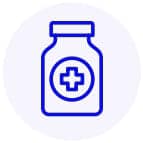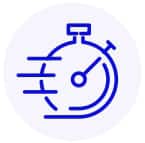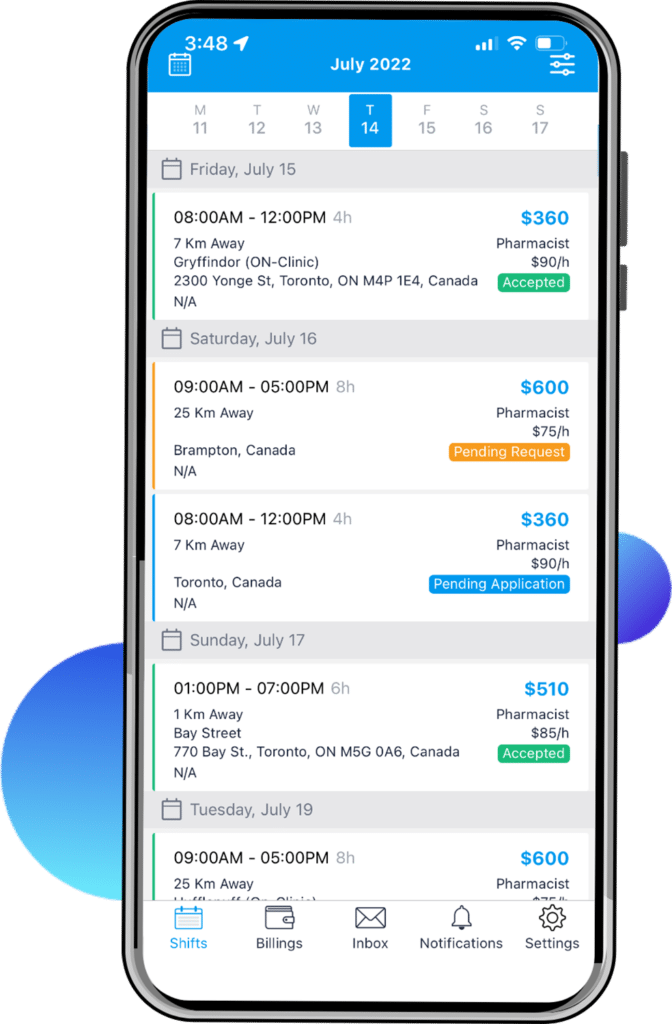Are you interested in a career in the medical field? You’ve come to the right place! Explore high-demand medical jobs, discover salaries, learn about education requirements, and find job outlooks for sought-after medical professions. From phlebotomists to midwives, every role plays a vital part in healthcare. You can make a significant difference in the well-being of others with a diverse range of medical career paths.
From a relief pharmacist to a home health aide and everything in between, let’s look at the medical careers most in demand in 2024.

Pharmacist
Pharmacists dispense medications, counsel patients, and ensure safe drug use across diverse healthcare settings. They’re pivotal in promoting optimal health outcomes in various settings such as community pharmacies, hospitals, relief positions, or pharmaceutical companies. They must be able to communicate well, focus on important details, and work well with customers.
Average salary in the United States:
$152,308
Average salary in Canada:
$131,480
Education needed:
- U.S. — High school diploma or GED, bachelor’s degree in a field like biology or medical chemistry, take and pass the Pharmacy College Admission Test (PCAT), Doctorate of Pharmacy. Pass two licensing exams through the North American Pharmacist Licensure Exam and get state-specific licensing.
- Canada — Bachelor’s degree in pharmacy, Doctorate of Pharmacy, board certification through the Pharmacy Examining Board of Canada. Complete an apprenticeship or internship at a pharmacy.
Predicted job outlook: Growth up to 3% by 2032
Relief Pharmacist
A relief pharmacist fills open pharmacy shifts, working at different locations based on staffing needs. They dispense medications, counsel patients, and manage inventory, and must have good communication skills, adaptability, and a keen eye for details.
Relief pharmacists have the unique opportunity to travel between states and provinces, gaining more experience as they work in different pharmacy environments and interact with new customers. They also have more freedom in their schedule, choosing where and when they want to work and for how much — this is an excellent way to take control of a pharmacy career and increase income at the same time!
Sign Up for ShiftPosts
Phlebotomist
Phlebotomists draw and collect blood samples from patients. They work in various settings, including laboratories, clinics, and hospitals, and must have strong organizational and communication skills and keen attention to detail.
Average salary in the United States:
$31,425
Average salary in Canada:
$46,164
Education needed:
- U.S. — High school diploma or GED and phlebotomy program certificate
- Canada — Graduate from a recognized Canadian Post-Secondary Institution in a Medical Discipline with phlebotomy training
Predicted job outlook: Growth up to 10% by 2028

Optometrist
An optometrist specializes in examining and diagnosing vision problems and eye disease. They typically work in clinics, private practices, or retail settings and prescribe contacts or glasses as needed. Optometrists need strong interpersonal skills to help educate patients about their eye care.
Average salary in the United States:
$150,448
Average salary in Canada:
$156,302
Education needed:
- U.S. — Bachelor’s degree and Doctor of Optometry degree
- Canada — Undergraduate degree, doctorate degree, and one-year residency program
Predicted job outlook: Growth of 10% by 2031

Physician Assistant
PAs work under the supervision of a physician and perform similar services. They can work in hospitals, clinics, or specialty practices and can complete physical exams, diagnose illnesses, and create treatment plans. PAs should have strong communication and analytical skills and adapt to fast-paced environments.
Average salary in the United States:
$121,972
Average salary in Canada:
$102,014
Education needed:
- U.S. — Bachelor of Science degree and a master’s degree focusing on physician assistant studies
- Canada — Undergraduate degree and a two-year physician assistant program
Predicted job outlook: Growth of 31% by 2029

Nurse Practitioner
Nurse practitioners (NPs) can diagnose, treat, and prescribe medications and work in clinics, hospitals, and primary care offices. NPs also complete physical assessments, manage chronic conditions, and order diagnostic tests to promote preventative care and overall health. They should have strong interpersonal skills and be able to communicate to help their patients feel at ease.
Average salary in the United States:
$124,226
Average salary in Canada:
$116,981
Education needed:
- U.S. — Master’s degree in nursing and a Doctorate of Nursing Practice (some states)
- Canada — Master’s degree in nursing or a nursing program with advanced primary nursing education
Predicted job outlook: Growth of 38% by 2032

Dentist
Dentists diagnose and treat oral health issues, providing services like cleanings, fillings, and extractions. They educate patients on proper oral hygiene and may perform cosmetic procedures. Attention to detail is essential during procedures, ensuring precision and patient comfort.
Average salary in the United States:
$230,162
Average salary in Canada:
$207,144
Education needed:
- U.S. — Bachelor’s degree and a Doctorate of Dental Surgery (DDS) or Doctorate of Dental Medicine (DMD)
- Canada — Undergraduate degree and a DDS, DMD, or BDS (Bachelor of Dental Surgery)
Predicted job outlook: Growth of 7% by 2034

Respiratory Therapist
Respiratory therapists specialize in respiratory care in hospitals or other healthcare settings. Their responsibilities include assessing patients with breathing disorders, conducting diagnostic tests, and administering treatments like oxygen therapy. They should have strong communication skills and remain calm in emergencies.
Average salary in the United States:
$70,514
Average salary in Canada:
$76,577
Education needed:
- U.S. — Associate’s degree (at minimum) from an accredited respiratory therapy program and can get a master’s degree in respiratory care
- Canada — Three-year college or university degree in respiratory therapy
Predicted job outlook: Growth of 13% by 2032

Pharmacy Technician
Pharmacy technicians assist pharmacists in dispensing medications. They work in pharmacies, hospitals, or retail settings and receive prescriptions, package medications, and manage inventory. Technicians also handle administrative tasks and interact with patients. They should have strong customer service skills and be highly organized to dispense prescriptions accurately.
Average salary in the United States:
$37,790
Average salary in Canada:
$49,164
Education needed:
- U.S. — High school diploma or GED and a one-year certificate or diploma from a pharmacy technician program
- Canada — Two-year pharmacy tech program and supervised practical training. Both options require passing a certification exam from the Pharmacy Examining Board of Canada
Predicted job outlook: Growth of 6% by 2032

Physical Therapist
Physical therapists work in hospitals, clinics, or rehabilitation centers to help patients recover from injuries or surgeries. They evaluate physical conditions, create treatment plans, and guide patients through exercises to improve their health. Effective communication and adaptability are crucial skills for working with other healthcare professionals and meeting the diverse needs of each patient.
Average salary in the United States:
$90,535
Average salary in Canada:
$88,335
Education needed:
- U.S. — Bachelor’s degree and a doctoral program in physical therapy
- Canada — Four-year undergraduate degree with PT-focused courses and a two-year master’s degree in physiotherapy
Predicted job outlook: Growth of 15% by 2032

Sonographer
A sonographer, also called an ultrasound tech, uses imaging equipment to capture internal images of a patient’s body. They work in hospitals, diagnostic centers, or physician offices and can assist in diagnosing medical conditions and monitoring pregnancy. Sonographers should have an excellent eye for details and communicate effectively to create accurate diagnostics.
Average salary in the United States:
$79,996
Average salary in Canada:
$79,307
Average salary in the United States: $79,996
Average salary in Canada: $79,307
Education needed:
- U.S. — Associate’s or bachelor’s degree with a focus on science and anatomy classes and a certificate in diagnostic medical sonography
- Canada — Three- to four-year program for medical sonography
Predicted job outlook: Growth of 10% by 2032

Midwife
A midwife provides more holistic care to pregnant women before, during, and after childbirth. They can work in hospitals and clinics or attend home births, provide personalized support, conduct prenatal exams, and assist with labor and delivery. Midwives need strong interpersonal skills and need to be able to stay calm in potential birthing emergencies.
Average salary in the United States:
$111,326
Average salary in Canada:
$95,172
Education needed:
- U.S. — Master of Science in Nursing with a specialty in midwifery
- Canada — Bachelor’s degree in midwifery education
Predicted job outlook: Growth of 38% by 2032

Massage Therapist
Massage therapists work in wellness centers, spas, or private practices, providing therapeutic massages to their clients. They assess clients’ injuries and pain, develop treatment plans, and perform massages to aid in pain relief and relaxation. A massage therapist needs good communication skills and the ability to create calm, comfortable environments for their clients.
Average salary in the United States:
$57,707
Average salary in Canada:
$67,859
Education needed:
- U.S. — Massage therapy certificate or diploma and pass the licensing exam
- Canada — Complete a massage therapy program (between 18 and 36 months) and register with a regulatory body
Predicted job outlook: Growth of 18% by 2032

Audiologist
Audiologists diagnose and treat hearing and balance disorders. They conduct hearing tests, provide rehab services, and recommend hearing aids. Audiologists need strong analytical and communication skills to create accurate assessments and treatment options. They can also work outside of direct patient care by participating in research or contributing to hearing health programs.
Average salary in the United States:
$82,770
Average salary in Canada:
$78,851
Education needed:
- U.S. — Bachelor’s degree and a Doctor of Audiology degree
- Canada — Bachelor’s degree and master’s degree in Audiology
Predicted job outlook: Growth of 11% by 2032

Dental Hygienist
Hygienists work with dentists and focus on preventive oral care. They can work in clinics, private practices, or community health settings and handle dental cleanings, oral health screenings, and patient education regarding oral health. Dental hygienists should have excellent attention to detail, good communication skills, and a calming presence to help patients with dental anxiety.
Average salary in the United States:
$90,671
Average salary in Canada:
$84,869
Education needed:
- U.S. — At least an associate’s degree in dental hygiene, but can also get a bachelor’s or master’s in the same field
- Canada — Two- to three-year college dental hygiene program
Predicted job outlook: Growth of 7% by 2032

Occupational Therapist
Occupational therapists assess clients’ needs and develop personalized intervention plans to help individuals perform daily activities. They work in hospitals, schools, or rehabilitation centers to address physical, cognitive, and emotional challenges and improve clients’ overall quality of life. OTs should have effective communication skills to speak with clients and their families.
Average salary in the United States:
$84,237
Average salary in Canada:
$82,146
Education needed:
- U.S. — Graduate from an accredited OT program and pass the exam from the National Board for Certification in Occupational Therapy
- Canada — Complete an entry-to-degree program for a Master of Science in occupational therapy and pass the national certification exam
Predicted job outlook: 12% by 2032

Optician
Opticians work in optical retail settings, interpreting prescriptions and assisting customers with selecting and fitting eyewear. They also repair or adjust glasses as needed. Opticians require strong customer service skills to recommend frames and explain lens options. Accuracy is important for taking measurements and ensuring proper lens alignment.
Average salary in the United States:
$53,019
Average salary in Canada:
$52,500
Education needed:
- U.S. — High school diploma or GED and on-the-job training or an associate’s degree or technical certificate
- Canada — Two- or three-year college program in optical sciences
Predicted job outlook: Growth of 3% by 2032

Radiation Therapist
Radiation therapists administer radiation treatments to cancer patients, and they usually work in treatment centers or hospitals. RTs operate specialized equipment, provide emotional support, and monitor patients during treatments. They need to be precise and pay close attention to the details to ensure they deliver accurate radiation dosages and should have exceptional communication skills.
Average salary in the United States:
$92,300
Average salary in Canada:
$85,618
Education needed:
- U.S. — Associate’s or bachelor’s degree in radiation therapy and pass a certification exam
- Canada — Two- to three-year college or approved program in diagnostic radiography or magnetic imaging
Predicted job outlook: Growth of 2% by 2032

Dietitian
Dietitians provide nutrition guidance to individuals or groups in hospitals, clinics, or community settings by assessing nutritional needs, developing meal plans, and educating clients on healthy eating habits. They can specialize in sports or clinical nutrition and collaborate with other healthcare teams. Strong communication skills help them motivate clients to make positive dietary changes.
Average salary in the United States:
$80,477
Average salary in Canada:
$80,594
Education needed:
- U.S. — Bachelor’s degree in nutrition
- Canada — Undergraduate degree in human nutrition and dietetics
Predicted job outlook: Growth of 7% by 2032

Registered Nurse
Registered nurses (RNs) work in various healthcare settings, administering medications, monitoring vital signs, and coordinating patient care plans. They collaborate with other healthcare professionals and require strong communication and critical thinking skills to provide safe and effective care.
Average salary in the United States:
$89,010
Average salary in Canada:
$73,185
Education needed:
- U.S. — Bachelor of Science in nursing and passing the NCLEX-RN exam
- Canada — Four-year bachelor’s degree in nursing, passing the NCLEX exam, and getting licensed in your province
Predicted job outlook: Growth of 16% by the end of 2024

Home Health Aide
Home health aides assist individuals with personal hygiene, meal preparation, and medication reminders. They work under healthcare professionals’ guidance and require qualities such as compassion and effective communication to build close relationships with clients and report any changes in their condition.
Average salary in the United States:
$28,514
Average salary in Canada:
$39,000
Education needed:
- U.S. — High school diploma or GED, formal training is provided on the job along with a standardized test
- Canada — High school diploma or equivalent and complete a home health aide training program
Predicted job outlook: Growth of 22% by 2032
Make the Most of High-Demand Jobs in Healthcare
There are so many medical careers in demand right now, and medical professionals have numerous job options to choose from. For pharmacy professionals who want to make the most of their careers, relief work is another exciting career option. With ShiftPosts, you can pick up open shifts when and where you want, giving you the flexibility to create a personalized work/life balance that meets your needs.
Download our app and get registered to take advantage of this pharmacy shift work opportunity and how it’s quickly becoming one of the most in-demand healthcare jobs in the industry.
Download the App












